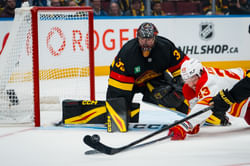
An ice hockey rink is a specially designed playing surface for a competitive team sport. Additionally, it serves as a venue for other sports such as broomball, ringette, rinkball, and rink bandy. The rink is characterized by its rectangular shape with rounded corners and is enclosed by walls approximately 1.22 meters (48 inches) high, commonly referred to as the boards.
The term "rink," derived from the Scots word meaning 'course,' originally denoted a location where curling, another game, was played. In the early stages of ice hockey history, the sport predominantly took place on rinks initially constructed for curling. Despite the subsequent construction of hockey-specific facilities, the term "rink" persisted, reflecting its historical association with the game.
What is the size of the NHL stadium series rink?
The NHL Stadium Series rink size dimensions typically adhere to the standard North American specifications set by the National Hockey League (NHL). The NHL rinks, used primarily in North America, measure 200 by 85 feet (60.96 m × 25.9 m) with a corner radius of 28 feet (8.5 m). Each goal line is positioned 11 feet (3.4 m) from the end boards, and the blue lines are situated 75 feet (22.9 m) from the end boards, with a distance of 50 feet (15.2 m) between them. This differs significantly from the international standard followed by the rest of the world, including Europe, and is regulated by the International Ice Hockey Federation (IIHF). The IIHF specifications for hockey rinks are 60.0 by 30.0 meters (196.9 ft × 98.4 ft) with a corner radius of 8.5 meters (27.9 ft), showcasing a notable difference in the width-to-length ratio on the ice.
Is there a standard NHL rink size?
Yes, there is a standard NHL rink size. NHL rinks, used primarily in North America, follow the specifications set by the National Hockey League. The standard dimensions for an NHL rink are 200 feet in length and 85 feet in width, with a corner radius of 28 feet. Each goal line is positioned 11 feet from the end boards, and the blue lines are situated 75 feet from the end boards, with a distance of 50 feet between them. This differs significantly from the international standard followed by the rest of the world, including Europe, which is regulated by the International Ice Hockey Federation (IIHF).
The dimensions of a hockey rink, whether smaller like those in North America or larger as in Europe, significantly impact gameplay styles. Smaller rinks, common in the United States, foster high-action, confrontational play, favoring physical players. In contrast, larger European rinks encourage a strategic approach with more emphasis on tactical plays.
The debate on standardizing rink sizes for international play persists, with arguments for fair competition but concerns about altering preferred playing styles. Recreational rinks may vary in size, catering to different needs, but understanding rink dimensions is crucial for players and enthusiasts.
FAQ's on NHL Stadium Series Rink Size
A. The NHL Stadium Series rink size is 200 by 85 feet, adhering to North American standards set by the NHL, different from the international standard of 60.0 by 30.0 meters regulated by the IIHF.
A. Rink size significantly influences gameplay. Smaller North American rinks foster high-action, confrontational play, while larger European rinks encourage a strategic approach with an emphasis on tactical plays.
A. An ongoing debate exists about standardizing rink sizes for international play, balancing fair competition with concerns about altering preferred playing styles.
A. Recreational rinks may vary in size, with smaller arenas common for community use, catering to children or recreational skaters.
A. The NHL Stadium Series rink size differs from the international standard due to historical associations with curling and emphasis on distinct North American playing styles.









